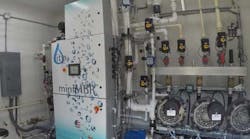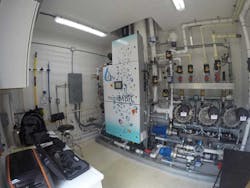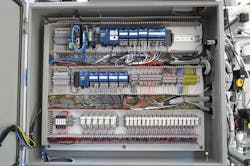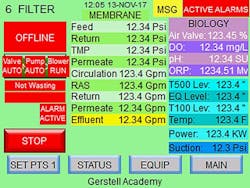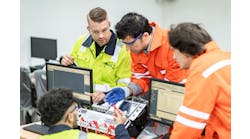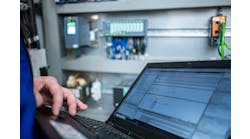Wastewater treatment plants can be built for small-scale applications
For most people, treatment of wastewater from homes and businesses is one of those it-just-happens things taken care of by local governments. But any facility too isolated to connect to a larger sewer system—such as a school, office or retailer—will have to supply its own treatment for obvious practical reasons and to avoid a variety of fines from environmental agencies.
These isolated locations often have too much water to treat using a septic tank, so they must provide their own wastewater treatment plant (WWTP), usually a miniature version of city-scale counterparts. The main operational problem these small-scale WWTPs face is flow variability. A small-scale WWTP is designed for an anticipated flow rate to cover the maximum the supported facility expects to generate but can struggle to operate properly when the flow is toward the low end of the range. This can be mitigated somewhat by adding storage tanks, but a better solution is to change the process to make it more inherently scalable.
This task of redesigning the process has been the objective of Innovative Treatment Products (ITP) in Owing Mills, Maryland, from its inception. By starting with a clean slate and avoiding the pitfalls of simply making smaller versions of large plants, new pre-packaged plants using membrane-bioreactor technology can operate continuously at 5% of rated capacity, while still delivering high discharge quality in compliance with the highest state and municipal regulations (Figure 1).
Figure 1: By starting with a clean slate and avoiding the pitfalls of simply making smaller versions of large plants, new pre-packaged plants using membrane bio-reactor (MBR) technology can operate continuously at 5% of rated capacity, while still delivering high discharge quality in compliance with the highest state and municipal regulations.
(Source: ITP)
ITP is an original equipment manufacturer (OEM) of wastewater-treatment equipment. It designs and manufactures complete, self-contained, packaged WWTPs for capacities ranging from 5,000 to 50,000 gallons per day. Additional products include:
- miniature membrane bio-reactor (the mini)
- Clarifier CleanSweep algae remediation system
- preScreen rotary-drum screen.
All miniMBR process equipment, with the exception of the reactor tanks, is contained on a single skid that arrives at the site ready to install and run.
Bugs at work
An MBR breaks down biological waste using naturally occurring bacteria. This is done in multiple phases in separate tanks as the bacteria tends to be specialized. The first step uses one type of bacteria to break down the solid material, while the second step uses a different type to convert ammonia in the wastewater into a nitrogen compound suitable for release back into the atmosphere.
The final step is removing the inert solid byproducts while keeping the various types of bacteria in the tanks where they belong. This is done using an ultrafiltration membrane with 0.03-micron pores to remove virtually all solids. With this filtration method, wastewater at a concentration of 10,000 mg/l of solids, which is very dark and thick, is turned into crystal-clear water in one step.
The wastewater being processed must move from stage to stage at the appropriate rates to allow the bacteria sufficient time to do its work. Additives must be dosed into the wastewater in the right amounts for optimal processing to use the available time efficiently based on the throughput demand at any given flow rate. As a result, the automation system controlling the installation must be able to perform sophisticated analysis of the operating parameters and make adjustments to match demand. Achieving this internal scalability is far more complex than designing a unit running at a constant flow rate.
Variable flow rates
The description so far understates the complexity of what’s going on inside the unit. Whether it’s the largest or smallest MBR-equipped plant, the equipment and control strategy are very similar. A typical unit uses 14 automated valves, four pumps and three blowers (Figure 2). Measuring progress of the process and the condition of the bacteria requires monitoring pH, oxidation-reduction potential (ORP) and dissolved oxygen (DO). Flowmeters and level instruments are also needed. All these elements are tied together by a programmable logic controller (PLC) automating the entire operation and by human-machine interfaces (HMIs) for monitoring and operator interface.
Figure 2: Whether it’s the largest or smallest MBR-equipped plant, the equipment and control strategy are very similar. A typical unit uses 14 automated valves, four pumps and three blowers.
(Source: ITP)
This PLC has a lot to do, so the application requires a versatile and sophisticated unit. ITP has been using AutomationDirect Do-more PLCs for some time, but it recently began using the new AutomationDirect BRX Series PLCs, a stackable micro brick design. It uses the same Do-more Designer Windows programming and documentation software as the other Do-more PLCs, so only a few simple changes were needed to integrate it into new systems in the production pipeline.
When wastewater begins to flow into the system, the process must be controlled precisely. For example, the pumps moving wastewater into the first part of the process are regulated by variable-frequency drives (VFDs) via a flow loop controlled by the PLC. The PID function in the BRX PLC keeps the flow at exactly the rate needed by the system.
The DO level must be maintained within a very narrow range. Too much oxygen wastes energy and can stop the second step of the process, denitrification. The PLC reads data from a DO probe and controls an adjustable air valve from the blowers to keep the level constant.
The solids content level increases during the process, so sludge must be extracted periodically. The PLC calculates the amount to be taken out each day based on the flow of the previous day and automatically extracts the correct amount to keep the concentration constant.
Membrane-filter maintenance
One of the most critical elements of the MBR system is the filter membrane. Since it captures all solids down to 0.03 microns, bacteria and most viruses get removed. To keep the membrane from fouling, there is an automatic backwash process performed every 10 minutes. This step reverses the flow through the membrane using various pumps and valves.
The membrane also needs periodic chemical cleanings. This is a 36-step process that includes filling, flushing, dosing of two chemicals, soaking, circulating, heating, dumping, refilling and monitoring over a period of about eight hours, usually overnight. This was a complex sequence to automate, but the PLC’s stage-programming functionality made it much easier.
Stage or state programming is an extension of normal relay ladder logic and works well for processes with clearly defined steps or states occurring multiple times during a sequence. The result is a robust process able to run time and time again without interruptions.
Performance with affordability
For ITP, being the least expensive among WWTP producers does not assure success because potential users might not be able to afford a solution from any vendor. Therefore, ITP must find ways to keep costs down, well below other competitors, while making sure this objective doesn’t sacrifice performance or reliability. The answer is to get the most from every dollar, and this takes a variety of forms.
System designers model everything, including electrical panels, using SolidWorks software. Equipment models are imported directly into the purchasing system which allows ITP to estimate, quote, purchase and assemble systems directly from the models. Material-receiver documents reference individual job and subassemblies, so incoming materials can be placed directly in the work-in-process bins dedicated to each job. This just-in-time approach to inventory keeps costs as low as possible.
ITP has a small but well-equipped shop to fabricate and machine unique system parts. It includes a CNC milling center that doubles as a CNC lathe, in addition to both plastic and metal welding capabilities. A core pillar of the company’s philosophy is: “Inventory is the enemy of innovation.” Therefore, it works toward processes allowing ITP to make one of any part quickly and economically. The large fiberglass tanks and buildings are supplied by a partner company.
Supplier selection
Choosing the market leader as the primary supplier for critical automation components can have its drawbacks. Some suppliers are very responsive, while others exploit their dominance at the expense of customers. Within the world of automation, the latter is often the case. Without naming names, let’s just say the market leader charges for tech support and has cumbersome distribution methods, which add cost and make it difficult to get critical parts in an emergency.
Fortunately, when it was time to design the control system for ITP’s first small MBR WWTPs, the decision was to start with a clean slate and choose the best automation supplier, not just the most recognizable name. With a plan to sell these treatment units nationwide, support would have to be available anywhere. And, since most units would be purchased by schools, parks, convenience stores and other small companies, low prices were very important.
AutomationDirect’s Do-more PLC was chosen for this application primarily for financial reasons, but it gets the job done well and is easy to support. Also, previous experience using AutomationDirect C-more HMIs and other components over six years made us very comfortable with the company’s capabilities and the product reliability (Figure 3).
Figure 3: Capable and reliable components provided opportunities to cut costs on flowmeters by using turbine designs and feeding the pulse-count output directly to a high-speed input on the PLC.
(Source: ITP)
These components also provided opportunities to cut costs in clever ways. For example, we save costs on flowmeters by using turbine designs and feeding the pulse-count output directly to a high-speed input on the PLC. This eliminates the cost of a transmitter to perform a conversion the PLC can easily do itself. Similarly, high-speed outputs are used to drive chemical-dosing pumps directly. This approach saves nearly 10% of our control system cost. In addition, the free Do-more Designer Windows programming and documentation software allows us to supply operators with the means to service a unit on site at no cost, simplifying troubleshooting.
PLC programing and HMI configuration
The PLC programming strategy takes advantage of the Do-more architecture by using a main program with subprograms for each feature of the system. Using just one control program with descriptive tag names and clear comments ensures everyone will still understand how the program works years from now. Not every system uses every feature, so setup parameters simply disable the subprograms not required.
Operators in the field often struggle with calculating dosing requirements and flow rates, so the PLC does those using its math block. For example, tanks can be vertical cylinders, horizontal cylinders or rectangular. The PLC calculates tank capacity in gallons, along with the current volume, regardless of tank shape.
The HMI plays a significant role, but it is changing. Displays on the actual unit are now smaller than in years past, and we have settled on AutomationDirect 6- and 7-inch C-more EA9 series touch panels. This is practical because users tend to rely on the C-more’s smartphone app for remote access to the equipment. By designing the graphics for a small display, everything is also easily readable remotely on a smartphone (Figure 4).
Figure 4: By designing the graphics for a small display, everything is also easily readable remotely on a smartphone.
(Source: ITP)
There are approximately 130 HMI screens in the system, and ITP has put a lot of effort into making them easy to access. We try to make them discoverable by asking, “When would operators need this function, and where would they tend to look for it?”
Every system has a built-in cellular modem, which gives technicians remote access from the first day, dramatically reducing startup costs. Every important parameter is trended, even a few the operators don’t see. This data often helps to identify sources of problems. Data is logged continuously to a memory stick and is available online via any Web browser.
Results
The first WWTP built by ITP was installed to support an old industrial building that contained about 20 small businesses. The building owner said it cost half the price of the other units under consideration and brought an end to a consent decree with the state, which was imposing huge fines.
The second unit was supplied in a fiberglass building and tank structure for immediate installation and operation. It was ready to run except for adjusting the operating parameters at delivery. It replaced an old plant that had never worked properly in 15 years, so the owners were trucking wastewater away twice a week. The next two systems replace two more failed systems, each only five years old.
The reason so many conventional small plants fail to work is a lack of scalability. They are designed to handle full “nameplate” flow, which usually includes a huge safety margin. Once installed, most of them operate at about 10% of capacity much of the time, and the processes can’t break down the effluent properly at such reduced rates.
ITP’s process design and advanced control system produces high discharge quality while operating as low as 5% of capacity. AutomationDirect control hardware is a very large part of the success. While there are sometimes pressures to use the industry’s market leader for the automation system—the added cost of equipment, software and support would make it impossible for many customers to afford our systems, so ITP plans to stick with what works for the company and its customers.
ALSO READ: How to hack programmable logic controllers
Sponsored Recommendations

Leaders relevant to this article:
